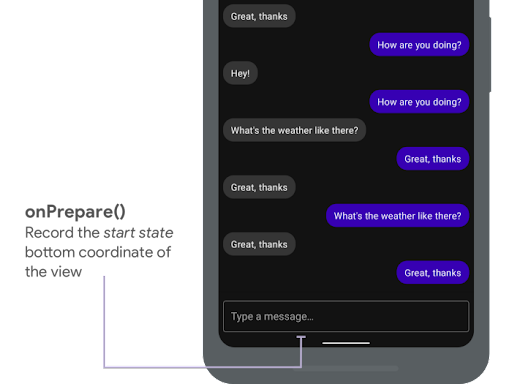使用 WindowInsetsCompat,
您的應用程式可以查詢及控制螢幕小鍵盤 (又稱為
IME) 類似
與系統資訊列互動的方式。您的應用程式也能使用
WindowInsetsAnimationCompat敬上
開啟或關閉螢幕鍵盤時,可創造流暢的轉場效果。
必要條件
設定螢幕鍵盤的控制項和動畫前,請先完成 在您的應用程式中顯示無邊框。這樣一來, 該元件會處理系統視窗插邊,例如 系統資訊列和螢幕小鍵盤。
檢查鍵盤軟體顯示設定
使用 WindowInsets 檢查軟體
。
Kotlin
val insets = ViewCompat.getRootWindowInsets(view) ?: return val imeVisible = insets.isVisible(WindowInsetsCompat.Type.ime()) val imeHeight = insets.getInsets(WindowInsetsCompat.Type.ime()).bottom
Java
WindowInsetsCompat insets = ViewCompat.getRootWindowInsets(view); boolean imeVisible = insets.isVisible(WindowInsetsCompat.Type.ime()); int imeHeight = insets.getInsets(WindowInsetsCompat.Type.ime()).bottom;
另外,您也可以使用
ViewCompat.setOnApplyWindowInsetsListener敬上
觀察軟體鍵盤顯示設定的變化。
Kotlin
ViewCompat.setOnApplyWindowInsetsListener(view) { _, insets ->
val imeVisible = insets.isVisible(WindowInsetsCompat.Type.ime())
val imeHeight = insets.getInsets(WindowInsetsCompat.Type.ime()).bottom
insets
}
Java
ViewCompat.setOnApplyWindowInsetsListener(view, (v, insets) -> {
boolean imeVisible = insets.isVisible(WindowInsetsCompat.Type.ime());
int imeHeight = insets.getInsets(WindowInsetsCompat.Type.ime()).bottom;
return insets;
});
使用螢幕鍵盤同步處理動畫
使用者輕觸文字輸入欄位時,鍵盤將滑出 畫面底端,如以下範例所示:
示例標示為「未同步處理」圖 2 顯示了預設行為 在 Android 10 (API 級別 29) 中,應用程式的文字欄位和內容 而不是與鍵盤的 — 可能在視覺上造成乾擾的行為。
在 Android 11 (API 級別 30) 以上版本中,您可以使用
WindowInsetsAnimationCompat,用於同步處理應用程式的轉換 鍵盤從螢幕底部向上和向下滑動。外觀 更流暢,如標示「已同步處理」的範例中如圖 2 所示
設定
WindowInsetsAnimationCompat.Callback敬上
與鍵盤動畫同步的檢視畫面。
Kotlin
ViewCompat.setWindowInsetsAnimationCallback(
view,
object : WindowInsetsAnimationCompat.Callback(DISPATCH_MODE_STOP) {
// Override methods.
}
)
Java
ViewCompat.setWindowInsetsAnimationCallback(
view,
new WindowInsetsAnimationCompat.Callback(
WindowInsetsAnimationCompat.Callback.DISPATCH_MODE_STOP
) {
// Override methods.
});
WindowInsetsAnimationCompat.Callback 中有幾種覆寫方法。
名叫
onPrepare(),
onStart(),
onProgress(),
和
onEnd()。
在任何版面配置變更前,先呼叫 onPrepare()。
插邊動畫開始及檢視畫面之前時,系統會呼叫 onPrepare
導致這些元素再次出現動畫您可以用它來儲存起始狀態
在本例中是檢視畫面的底部座標。

onPrepare():
記錄啟動狀態
下列程式碼片段顯示對 onPrepare 的呼叫範例:
Kotlin
var startBottom = 0f
override fun onPrepare(
animation: WindowInsetsAnimationCompat
) {
startBottom = view.bottom.toFloat()
}
Java
float startBottom;
@Override
public void onPrepare(
@NonNull WindowInsetsAnimationCompat animation
) {
startBottom = view.getBottom();
}
插邊動畫開始時,系統會呼叫 onStart。您可以使用它來設定
版面配置的結束狀態會變更。如果您有
設為任何檢視畫面的 OnApplyWindowInsetsListener 回呼,表示已
稱為這個元件建議您趁此機會儲存檢視畫面的結束狀態
資源。

onStart() 錄製
結束狀態
下列程式碼片段顯示對 onStart 的呼叫範例:
Kotlin
var endBottom = 0f
override fun onStart(
animation: WindowInsetsAnimationCompat,
bounds: WindowInsetsAnimationCompat.BoundsCompat
): WindowInsetsAnimationCompat.BoundsCompat {
// Record the position of the view after the IME transition.
endBottom = view.bottom.toFloat()
return bounds
}
Java
float endBottom;
@NonNull
@Override
public WindowInsetsAnimationCompat.BoundsCompat onStart(
@NonNull WindowInsetsAnimationCompat animation,
@NonNull WindowInsetsAnimationCompat.BoundsCompat bounds
) {
endBottom = view.getBottom();
return bounds;
}
在執行動畫的過程中,插邊變更時,系統會呼叫 onProgress。
因此你可以覆寫設定,並在使用鍵盤時於每個畫面收到通知
更新檢視畫面屬性,讓檢視畫面以動畫形式呈現
可與鍵盤同步處理
現在,所有版面配置變更都已完成。舉例來說,如果您使用
View.translationY 來移動檢視畫面,值會在每次
呼叫此方法後,最終會到達 0 的原始版面配置位置。
onProgress():
同步處理動畫。
下列程式碼片段顯示對 onProgress 的呼叫範例:
Kotlin
override fun onProgress(
insets: WindowInsetsCompat,
runningAnimations: MutableList<WindowInsetsAnimationCompat>
): WindowInsetsCompat {
// Find an IME animation.
val imeAnimation = runningAnimations.find {
it.typeMask and WindowInsetsCompat.Type.ime() != 0
} ?: return insets
// Offset the view based on the interpolated fraction of the IME animation.
view.translationY =
(startBottom - endBottom) * (1 - imeAnimation.interpolatedFraction)
return insets
}
Java
@NonNull
@Override
public WindowInsetsCompat onProgress(
@NonNull WindowInsetsCompat insets,
@NonNull List<WindowInsetsAnimationCompat> runningAnimations
) {
// Find an IME animation.
WindowInsetsAnimationCompat imeAnimation = null;
for (WindowInsetsAnimationCompat animation : runningAnimations) {
if ((animation.getTypeMask() & WindowInsetsCompat.Type.ime()) != 0) {
imeAnimation = animation;
break;
}
}
if (imeAnimation != null) {
// Offset the view based on the interpolated fraction of the IME animation.
view.setTranslationY((startBottom - endBottom)
* (1 - imeAnimation.getInterpolatedFraction()));
}
return insets;
}
您可以視需要覆寫 onEnd。系統會在動畫結束後呼叫此方法
已結束。建議您趁此機會清除任何暫時變更。

